HTC’s Vive Focus 3 is a standalone VR headset, with optional PC connectivity, which is primarily aimed at businesses — something that’s evident from its $1,300 price tag (£1,272 inc. VAT in the UK). There are entertaining experiences to be had using this high-quality VR hardware, but its main target market is organisations that are willing to pay handsomely for a cutting-edge training, collaboration, product design or marketing tool.
Competition for the Vive Focus 3 comes in the shape of the business version of Facebook’s Oculus Quest 2, which costs $799 and uses the Oculus for Business platform (no Facebook login required), accesses apps on the Business Release Channel in the app store, has a Device Setup app for provisioning, and comes with enterprise customer support. The consumer version of the Oculus Quest 2, which requires a Facebook login, costs just $299 with 64GB of storage, or $399 with 256GB.
HTC’s Vive Focus 3 is therefore 63% more expensive than its main business-focused competitor, and costs over three times more than the entry-level consumer Oculus Quest 2. It’s a big ask, but does it justify that differential?

HTC’s standalone Vive Focus 3 is based on Qualcomm’s Snapdragon XR2 SoC with 8GB of RAM and 128GB of internal storage. The headset weighs 785g.
Images: Charles McLellan / ZDNet
Design
At first glance, the matte-black Vive Focus 3 looks like a bulky and heavy piece of headgear, but it’s actually reasonably comfortable to wear. The visor section is counterbalanced at the back by the curved, padded battery compartment and the adjustment mechanism for the headset band, and although it weighs 785g, it’s feasible to use for VR sessions of up to an hour or so.
You adjust the sides of the headset band, which incorporates directional speakers on each side, using a circular dial at the back, underneath which there’s a quick-release catch that makes it easy to remove the headset. There’s also an adjustable fabric strap that goes over the top of your head, which is secured by Velcro.
The cushioned portions of the visor and battery sections are both easily — sometimes too easily — removed from their magnetic attachments, for cleaning or replacement. Behind the face cushion you’ll find the dual-element Fresnel lenses, and a MicroSD slot on the left-hand side. Removing the rear cushion reveals the curved 26.6Wh lithium polymer gel battery, which is also removable. The battery is charged via the supplied 12V adapter, which has a fixed cable and a round-pin connector that plugs into the top, on the right side. Below this are four status LEDs and a button: a short press shows the charge level, while a long (3-second) press boots up the headset.
There are various ports and controls dotted around the headset. The right side of the visor carries a USB-C port for charging the controllers (via a supplied splitter cable) and for PC connection, plus a 3.5mm audio jack. On the opposite side there’s a Headset button for activating passthrough mode, selecting items in Gaze mode, forcing unresponsive content to quit and opening the system menu. The underside has a dial for adjusting IPD (Inter-Pupillary Distance) and a second USB-C port (under a magnetic cover) in the middle, plus a volume rocker and a microphone on the left. On the top you’ll find a headset LED and a second mic. Finally, looking at the visor face-on, you’ll see four cameras, one in each ‘corner’, which track the positions of the headset and the controllers, and allow you to see your surroundings when you flip from VR mode into passthrough mode.
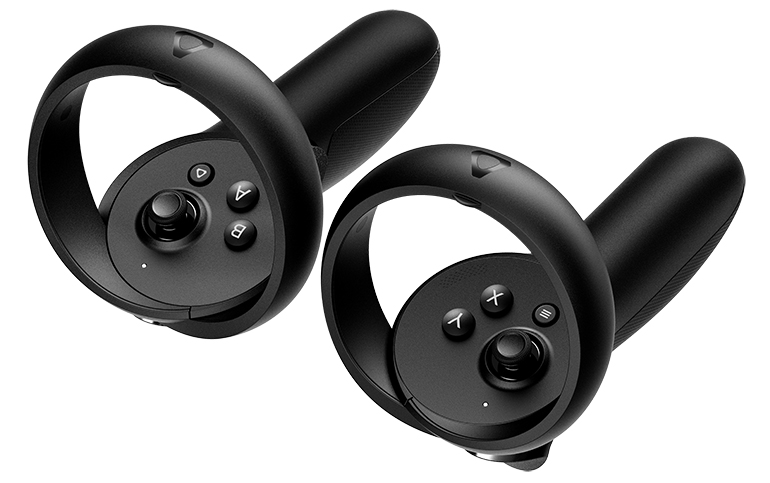
The Vive Focus 3 controllers charge via the headset’s USB port or a separate USB charger (not supplied) using a Y-shaped splitter cable (supplied). You can expect around 15 hours between charges.
Image: HTC
The handheld controllers are lightweight (142g) devices with contoured handles and circular housings for the infrared tracking sensors. Each controller has trigger and grip buttons, and a thumbstick, with menu and XY buttons on the left controller, and Vive and AB buttons on the right controller. There are proximity sensors on the trigger and grip buttons, capacitive sensors on
the trigger, joystick and thumb rest area, plus an accelerometer and a gyroscope. The controllers charge via USB-C and last for up to 15 hours, according to HTC.
Features
Like the Oculus Quest 2, the Vive Focus 3 is based on Qualcomm’s Snapdragon XR2 system-on-chip (SoC), backed up by 8GB of RAM and 128GB of internal storage (expandable to 2TB via the aforementioned MicroSD card slot). An active cooling system — including airflow intake and output vents on the front of the headset, a 15W copper heat pipe and a cooling fan — allows HTC to extract maximum performance from the XR2 chipset without any overheating.
The Vive Focus 3 runs on an Android-based OS, accesses content via the Vive Business Appstore, and provides the Vive Business Device Management System for admins to manage multiple headsets and users.
The Vive Focus 3’s headline features are its ‘industry-leading’ 5K resolution (2448 x 2448 pixels per eye, or 4896 x 2448 pixels combined, via dual 2.88-inch LCDs), 90Hz refresh rate, wide field of view (up to 120˚ via dual-element Fresnel lenses) and ‘real RGB sub-pixels’.
The four inside-out tracking cameras are mounted in the headset’s magnesium alloy frame, which as well as adding durability also helps with heat dissipation. The high-FoV cameras use an AI algorithm that processes and stores encrypted tracking data securely on the device.
User experience & performance
According to HTC, the best way to set up Vive Focus 3 for ‘individuals, teams and small businesses’ is with Vive Manager, a mobile app available on Android and iOS. With the headset on, you fire up the mobile app to get a Bluetooth pairing code; when the same code displays on the headset, you press the Headset button to pair the devices. You can then set up wi-fi and pair the controllers via your phone, and follow on-headset instructions for adjusting the IPD, setting the speaker volume and defining the play area (minimum 1.5m x 1.5m, maximum 10m x 10m). If Vive Manager isn’t available, you can do the entire setup from the headset (press and hold the Headset button from the welcome screen) and also apply firmware updates, but it’s easier via the mobile app.
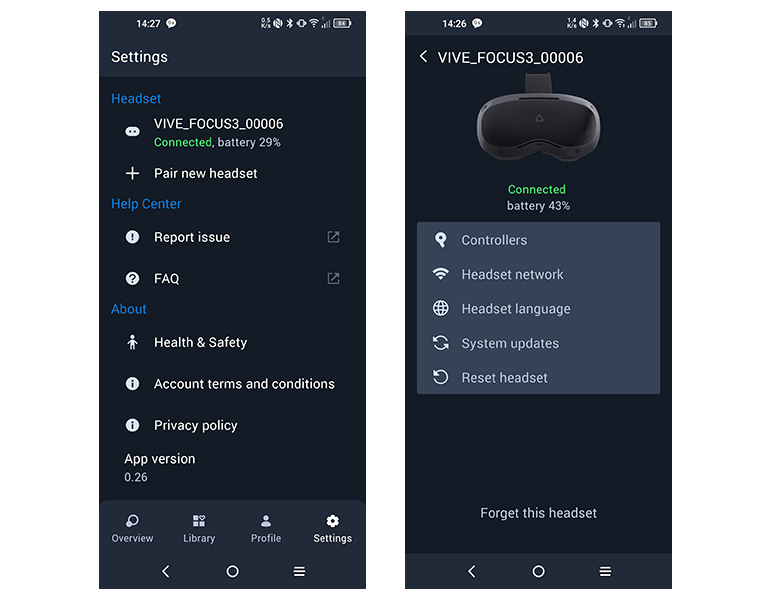
You can set up and configure the Vive Focus 3 via the Vive Manager mobile app.
Images: Charles McLellan / ZDNet
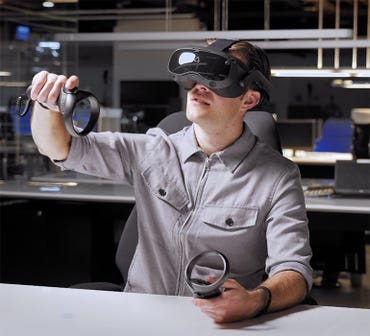
The Vive Focus 3 headset is comfortable to wear, and the controllers fit well in the hand.
Image: HTC
You can’t avoid looking somewhat ridiculous wearing a VR headset, but at least HTC’s Vive Focus 3 allows you to do so in relative comfort. It’s not too heavy, it’s well balanced thanks to the rear-mounted battery, the straps are easily adjustable, and the quick-release button at the back works well. The padded gaskets for the headset and battery sections remove easily for cleaning, which is important if the headset is to be used by multiple people throughout the day — in training sessions, for example. You can use the headset with glasses up to 150mm wide if needed, and the adjustable IPD dial goes from 57mm to 72mm, which should allow most people to fit the headset comfortably to their eyes.
As far as image quality goes, the 5K resolution and 120˚ field of view afforded by the dual-element lenses gives an expansive feel to the VR experience, although the concentric nature of the Fresnel lens design does give rise to ‘god ray‘ artefacts with high-contrast images. Perhaps more importantly for a business-focused device, it can be hard to find a sweet spot where text is sharp and easy to read (although it must be noted that my eyesight is distinctly sub-20/20). Another potential irritation is the cooling fan, which is both audible and creates airflow across your face.
HTC doesn’t make a battery life claim for the 26.6Wh battery, but we’ve seen around 2-3 hours quoted, depending on the workload, and that matches our experience. If the headset is to be used continuously through the day, you’ll probably want to have a second battery on charge, ready to swap in as required (hot-swapping is not supported though). Otherwise, fast charging support lets you go from zero to 50% in half an hour.
The directional speakers in the headset band worked fine for me, offering a good trade-off between volume and sound leakage to the surroundings. There are settings to enhance audio privacy, and also to minimise microphone noise. However, if you don’t like the built-in speakers, there’s a 3.5mm headset jack on the right side of the headset.
My review unit came with several VR titles preloaded: Vive Sync (virtual office/collaboration space); Firefox Reality (VR browser with WebXR support); Mona Lisa: Beyond the Glass (a VR tour of the Da Vinci masterpiece); Bodyswaps (workplace soft skills training); Sentient Hazard Awareness (immersive hazard training); ORama (VR medical training); Virti (immersive medical training); and The Sick Rose (VR animation).
To access new titles you can browse through HTC’s Vive Business AppStore in the Vive Manager mobile app, although you have to go to the website to make purchases and get titles into the Library on the headset.
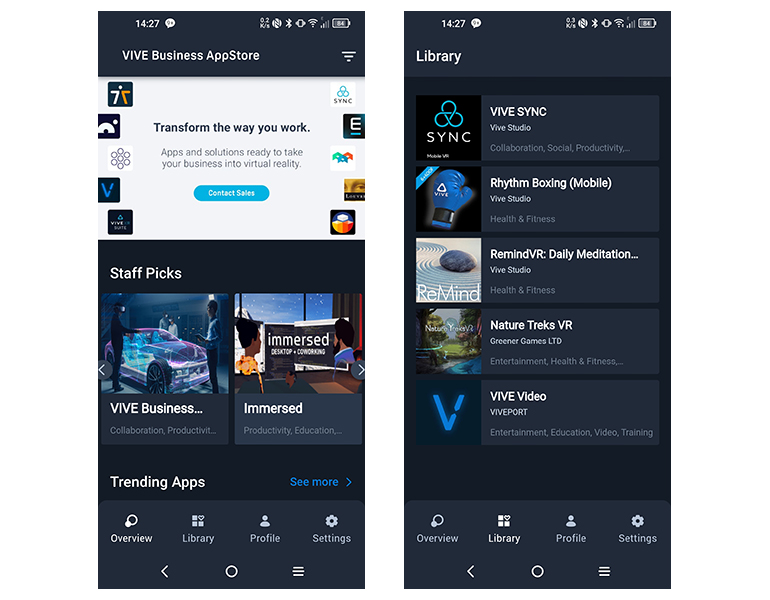
You can browse, but not purchase, VR titles in the business app store in the Vive Manager app. To make purchases, you have to visit the website.
Images: Charles McLellan / ZDNet
You can also access the Vive Business AppStore from the ‘Lobby’ (a modernist office space in a desert location) on the headset, which also has dialogs for installed content (Library), Settings and your HTC account (Profile):
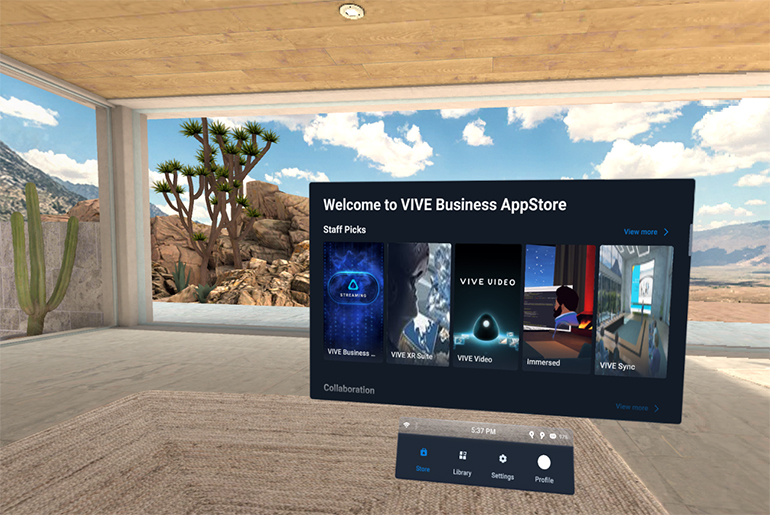
The Vive Focus 3’s Lobby, with business app store.
Image: Charles McLellan / ZDNet
The Settings dialog has sections entitled General, Boundary, Connectivity, Network, Kiosk Mode, Storage and Advanced:

The Settings dialog lets you tweak the Vive Focus 3’s configuration.
Image: Charles McLellan / ZDNet
Boundary is where you set the floor level and the extent and characteristics of the play area. Connectivity covers controllers, Bluetooth, hand tracking (a developer feature) and linking to the Vive Manager mobile app, while Network covers wi-fi and VPN connections. Kiosk Mode lets you configure the headset to access particular apps, denying users full control of the headset, while Storage shows available free space, provides a file manager and lets you uninstall apps. The Advanced dialog includes USB debugging, app install from unknown sources, sleep mode and camera settings, plus device reset.
One of HTC’s key business offerings is Vive Sync, a VR meeting and collaboration platform designed to bring remote workers together in virtual meeting spaces, armed with a rich set of productivity tools. You also can join Vive Sync meetings from your PC or mobile phone if you don’t have access to a VR headset.
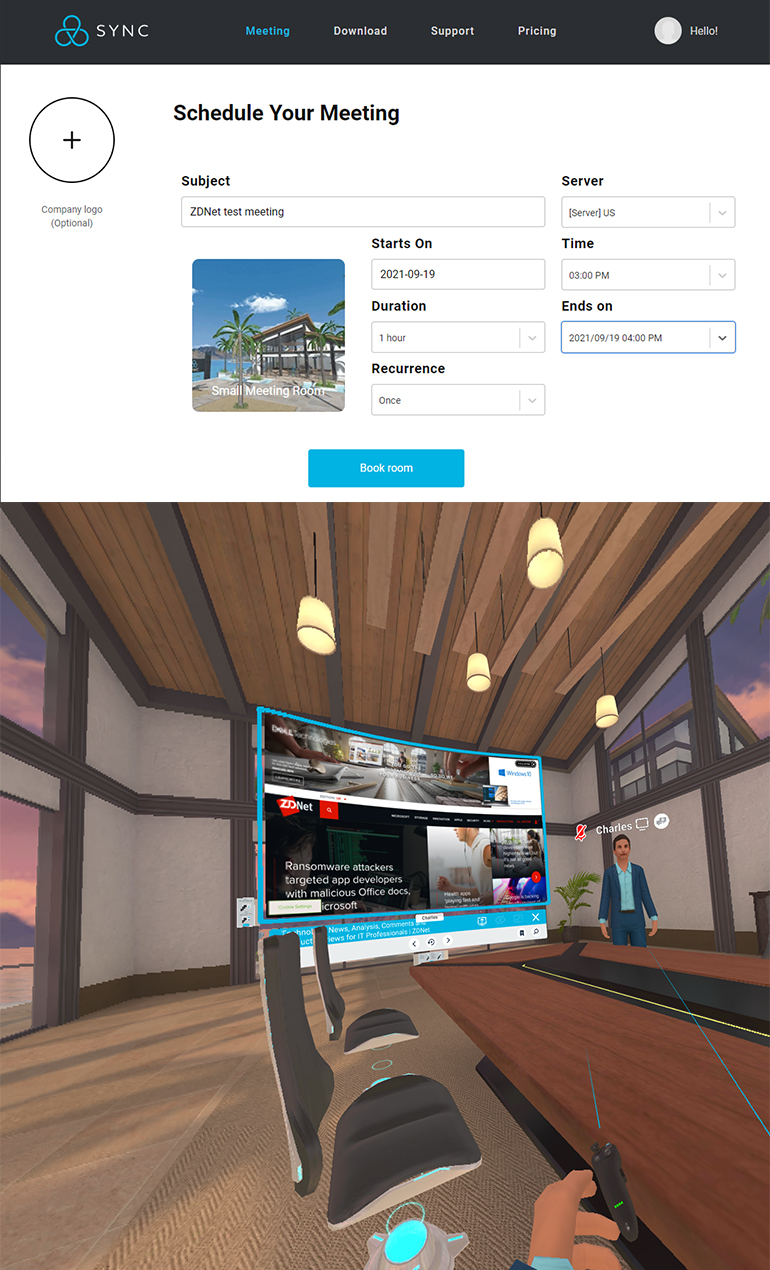
Setting up (top) and attending (above) a virtual meeting in HTC Sync’s ‘ocean view’ meeting room space. You can customise avatars to make your virtual self more realistic.
Images: Charles McLellan / ZDNet
Whether VR meetings are the future of remote collaboration is a moot point (Facebook’s recently unveiled Horizon Workrooms met with plenty of scepticism, for example). However, I couldn’t help but be impressed by the level of functionality on offer in HTC’s Vive Sync, which has been around since 2018.
To cater for more demanding VR apps, the Vive Focus 3 supports PC-based streaming via Vive Business Streaming. This works best with HTC’s dedicated 5m Vive Business Streaming USB Cable, a separate purchase — not included in our review kit — costing $79 (£89 in the UK). PC-based streaming, which supports both HTC’s Viveport and the SteamVR library, can also utilise a wi-fi (5 or 6) connection.
Conclusions
HTC’s Vive Focus 3 is a high-quality VR headset with a price tag that signals its business rather than consumer focus — which is why we’re reviewing it here on ZDNet. You can access consumer VR content using the Vive Focus 3, but for best results you’ll need the USB cable, which adds to an already hefty price tag. Businesses will be less concerned about the cost, and more interested in the quality and utility of the content that the platform can support. VR meetings may or may not be the future of remote collaboration, but there are enough other use cases, particularly in areas like immersive training and product design/demonstration, to make the Vive Focus 3 interesting to organisations in many sectors.
RECENT AND RELATED CONTENT
Facebook brings metaverse to work with Horizon Workrooms (and you thought Zoom fatigue was bad)
“In person” classes offered in virtual reality
VR puts nail in the coffin for cadavers
Augmented Reality, book review: Exploring the attractive and alarming potential of AR
Best VR and AR headset 2021
Read more reviews
Stay connected with us on social media platform for instant update click here to join our Twitter, & Facebook
We are now on Telegram. Click here to join our channel (@TechiUpdate) and stay updated with the latest Technology headlines.
For all the latest Technology News Click Here
For the latest news and updates, follow us on Google News.
